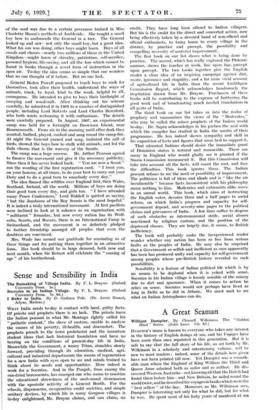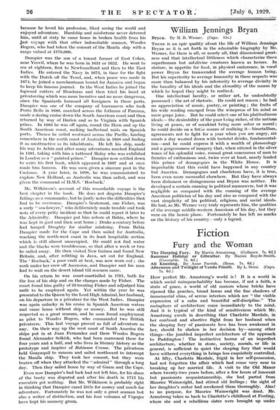A Great Seaman
DAMPIER'S name is known to everyone who takes any interest in the history of English doings at sea, and his Voyages have been more than once reprinted in this generation. But it is safe to say that the full story of his life, as set forth by Mr. Wilkinson in a scholarly and entertaining volume, will be new to most readers ; indeed, some of the details here given have not been printed till now. Yet Dampier was a remark- able man whom the England of King William the Third and Queen Anne admired both as sailor and as author. He dis- covered Western Australia—not knowing all that the Dutch had found there before him—and New Britain, he sailed round the world twice, and he described his voyages in books which were the "best sellers" of the day. Moreover, as Mr. Wilkinson sees, Dampier is interesting not only for what he did, but for what he was. He spent most of his forty years of manhood at sea because he loved his profession, liked seeing the world and enjoyed adventure. Hardship and misfortune never deterred him, until at sixty he came home in broken health from his jast voyage with that other indomitable seaman, Woodes Rogers, who had taken the consort of the Manila ship with a cargo valued at £170,000.
Dampier was the son of a tenant farmer of East Coker, near Yeovil, where he was born in 1651 or 1652. He went to sea at eighteen, first to Newfoundland and then to the East Indies. He entered the Navy in 1673, in time for the fight with the Dutch oft the Texel, and, when peace was made in 1674, he joined a merchantman bound for Jamaica and began to keep his famous journal. In the West Indies he joined the logwood cutters of Honduras and then tried his hand at privateering which was more lucrative and no more dangerous, since the Spaniards harassed all foreigners in those parts. Dampier was one of the company of buccaneers who took Porto Bello in 1680, marched across the Isthmus of Panama, made a daring cruise down the South American coast and then returned by way of Darien and so to Virginia with Spanish prizes. In 1683 he was off again, round the Horn and up the South American coast, making ineffectual raids on Spanish ports. Thence he sailed westward across the Pacific, landing somewhere in the north coast of Australia in 1688 and finding it as unattractive as its inhabitants. He left his ship, made his way to Achin and after many adventures reached England in 1691, taking with him a tattooed Malay who was exhibited in London as a painted prince." Dampier now settled down to write his first book, which appeared in 1697 and at once made him famous. He was soon given a sinecure post in the Customs. A year later, in 1698, he was commissioned to explore New Holland, as Australia was then called, and was given the command of H.M.S. 'Roebuck.'
Mr. Wilkinson's account of this remarkable voyage is the best chapter in the book. He does not disguise Dampier's failings as a commander, but he justly notes the difficulties that had to be overcome. Dampier's lieutenant, one Fisher, was a surly "sea-lawyer," who deliberately made trouble and took note of every petty incident so that he could report it later to the Admiralty. Dampier put him ashore at Bahia, where he was kept in gaol and then sent home ; Drake a century before had hanged Doughty for similar misdoing. From Bahia Dampier made for the Cape and then sailed for Australia, reaching the north-west coast in its least hospitable section which is still almost unoccupied. He could not find water and the blacks were troublesome, so that after a week or two he sailed away. He then visited New Guinea and found New Britain, and, after refitting in Java, set out for England. The 'Roebuck,' a poor craft at best, was now worn out ; she sank under her crew off Ascension, and Dampier and his men had to wait on the desert island till rescuers came.
On his return he was court-martialled in 1701, both for the loss of his ship and on the charges made by Fisher. The court found him guilty of ill-treating Fisher and adjudged him unfit to be employed again. Yet within the year he was presented to the Queen by the Lord High Admiral, her husband, on his departure in a privateer for the West Indies. Dampier was again unlucky in his cruise in Spanish American waters and came home without ship or money. But he was still respected as a great seaman, and he soon found employment as pilot to Woodes Rogers, who commanded two British privateers.. . This last voyage proved as full of adventure as any. On their way up the west coast of South America the ships put in at Juan Fernandez and there Woodes Rogers found Alexander Selkirk, who had been marooned there for four years and a half, and who lives in literary history as the prototype and inspirer of Robinson Crusoe. The privateers held Guayaquil to ransom and sailed northward to intercept the Manila ship. They took her consort, but they were beaten off when they attacked the "admiral" through a long day. Then they sailed home by way of Guam and the Cape.
Even now Dampier's bad luck had not left him, for his share of. the booty was disputed and after his death in 1715 his executrix got nothing. But Mr. Wilkinson is probably right in thinking that Dampier cared little for money and much for adventure. Fortunately he was not only a groat seaman but also a writer of distinction, and his four volumes of Voyages have kept his memory green.











































 Previous page
Previous page